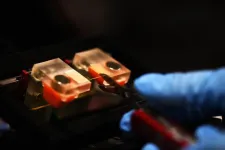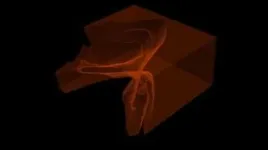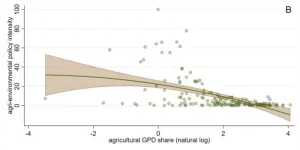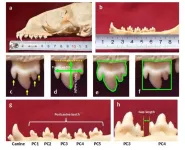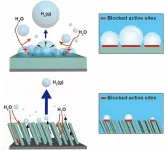(Press-News.org) The last time you dropped a favorite mug or sat on your glasses, you may have been too preoccupied to take much notice of the intricate pattern of cracks that appeared in the broken object. But capturing the formation of such patterns is the specialty of John Kolinski and his team at the Laboratory of Engineering Mechanics of Soft Interfaces (EMSI) in EPFL’s School of Engineering. They aim to understand how cracks propagate in brittle solids, which is essential for developing and testing safe and cost-effective composite materials for use in construction, sports, and aerospace engineering.
But traditional mechanics approaches to analyzing crack formation assume that cracks are planar – i.e., that they form on the two-dimensional surface of a material. In fact, simple planar cracks are just the tip of the iceberg: most cracks – like those in everyday brittle solids like glass – propagate into three-dimensional networks of ridges and other complex features.
Due to material opacity and the speed with which cracks form, observing this complexity in real time is extremely difficult. But now, armed with a Swiss Army knife and a confocal microscope, Kolinski and his team have managed to do just that – and they have discovered a positive correlation between crack complexity and material toughness in the process.
“The energy required to drive cracks has traditionally been considered a material property, but our work yields unique insights into the key role of geometry: namely, that by increasing the complexity of geometric features at the crack tip, a material can be made effectively tougher, because more strain energy is required to advance a complex crack than a simple one,” Kolinski says. “This highlights an important gap in the current theory for 3D cracks.”
The lab’s results have recently been published in Nature Physics.
A fundamental link between length and strength
The researchers’ method involved creating very thin slices of four different hydrogels and an elastomer. Transparent and brittle, but easy to deform and measure without shattering, the hydrogels served as a proxy for understanding how cracks form in glass and brittle plastics. The elastomer was likewise a proxy for materials like rubber and silicone polymers.
While the experimental cracks were observed with a state-of-the-art confocal microscope, they were induced using a standard Swiss Army knife: the shearing action of the device’s scissors naturally produced geometrically complex cracks in the hydrogel samples. Using a custom apparatus developed by the EMSI team to control sample alignment and loading, a series of fluorescent images was generated with the confocal microscope, and then stacked to assemble a unique, three-dimensional map of each fracture surface.
“People have long known that cracks can become complex by looking at fracture surfaces after the fact, but what is lost is the understanding of the loading conditions when the crack emerged, or what forces the sample was exposed to,” Kolinski explains. “Our innovative imaging method has made it possible to characterize this relationship rigorously in-situ.”
In a nutshell, these experiments revealed that the strain energy required to drive the sample cracks was directly proportional to the lengths of the crack tips. This suggests that the increased geometric complexity of a 3D crack generates more fracture surface as the crack advances, thus requiring additional strain energy to drive it.
In another experiment, the researchers showed how, as a smoother crack approached a rigid obstacle embedded in the sample, the crack’s planar symmetry was broken, increasing both the crack tip length and the energy required to drive the crack forward.
“The fact that we can isolate how geometric complexity emerges with such an inhomogeneity in the material could motivate new design approaches,” Kolinski says. “Our work also highlights the importance of care in carrying out materials testing, as we now know that any geometric deviation from a planar crack front may lead to a mis-measurement – and potentially dangerous over-estimation – of material toughness.”
END
3D images reveal link between crack complexity and material toughness
By capturing a rare glimpse into three-dimensional crack formation in brittle solids, EPFL researchers have found that complex cracks require more energy to advance than simple ones; a discovery that could improve materials testing and development.
2024-03-22
ELSE PRESS RELEASES FROM THIS DATE:
Decommissioned offshore structures could offer only limited ecological benefits
2024-03-22
Decommissioned offshore structures offer limited long-term ecological benefits if they are simply left in the ocean to serve as artificial reefs, a new study suggests.
The research, published in the journal Nature Sustainability, saw researchers carrying out a comprehensive analysis of existing studies into the environmental impacts of marine artificial structures – including oil and gas platforms and offshore wind farms – all over the world.
It highlighted that such installations can offer some ecological benefits – including increasing the diversity and abundance of fish species – in areas where the ...
All countries’ agri-environmental policies at a glance
2024-03-22
There can be no analysis without data. In this spirit, researchers from the University of Bonn and the Swiss Federal Institution of Technology (ETH) Zurich have published a database containing over 6,000 agri-environmental policies, thus enabling their peers as well as policymakers and businesses to seek answers to all manner of different questions. The researchers have used two examples to demonstrate how this can be done: how a country’s economic development is linked to its adoption of agri-environmental policies and how such policies impact soil erosion. Their study has now been published in “Nature Food.” Embargo: Don´t publish before March 22, ...
Bees need food up to a month earlier than provided by recommended pollinator plants
2024-03-22
Embargoed until 08:00 AM GMT / 04:00 AM ET Friday 22 March 2024
Bees need food up to a month earlier than provided by recommended pollinator plants
Plant species which are recommended as ‘pollinator friendly’ in Europe begin flowering up to a month too late for bees, resulting in low colony survival and low production of queens.
This is the first time that research has quantified the decline in colony survival and queen production due to a shortage of early season food.
Enhancing ...
Discovery of a hidden quantum critical point in two-dimensional superconductors
2024-03-22
Weak fluctuations in superconductivity1, a precursor phenomenon to superconductivity, have been successfully detected by a research group of Tokyo Institute of Technology (Tokyo Tech). This breakthrough was achieved by measuring the thermoelectric effect2 in superconductors over a wide range of magnetic fields and over a wide range of temperatures from much higher than the superconducting transition temperature to very low temperatures near absolute zero. This revealed the full picture of fluctuations in superconductivity ...
Multi-cusped postcanine teeth are associated with zooplankton feeding in phocid seals.
2024-03-22
The morphology of an animal's teeth often reflects its diet. A well-known example of a mammal that feeds in the water is the crabeater seal (Lobodon carcinophaga), which consumes large amounts of zooplankton. Crabeater seals have complex, jagged teeth, which are believed to function as a sieve to retain krill in their mouths and filter it from seawater. Furthermore, recent studies have shown that the Baikal seal (Pusa sibirica) also preys on large quantities of zooplankton and possesses distinctive jagged teeth. Thus, while behavioral observations and tooth morphology studies suggest a ...
Outcomes after stem cell transplant in elderly patients with acute myeloid leukemia have improved since 2000
2024-03-22
Bottom Line: Among patients over 65 who received an allogeneic hematopoietic stem cell transplant (allo-HCT) for the treatment of acute myeloid leukemia (AML) between 2000 and 2021, leukemia-free and overall survival improved significantly over time.
Journal in Which the Study was Published: Clinical Cancer Research, a journal of the American Association for Cancer Research (AACR)
Author: Ali Bazarbachi, MD, PhD, senior author of the study and a professor at the American University of Beirut in Lebanon
Background: AML ...
Longer genes are linked to aging
2024-03-22
· Long genes have more potential sites for DNA damage
· Genes involved in brain loss during aging and linked to Alzheimer’s are very long
· New view of biological aging differs from previous beliefs
CHICAGO --- What causes our body to age? Four complementary studies, including one from Northwestern Medicine, have come to the same conclusion: long genes.
In a new paper, the scientists write about their findings and how they advance existing knowledge about aging.
“Long genes ...
Revolutionizing hydrogen production: Economical and efficient solutions unveiled
2024-03-22
Water eletrolysis process is a system that produces hydrogen by electrolyzing water. It is an eco-friendly technology that can produce hydrogen fuel, a future energy source, without emitting environmental pollutants, but its limitations have been pointed out as low hydrogen production efficiency and high production costs. Recently, a team of researchers from Pohang University of Science and Technology (POSTECH) published research that solved both problems at once, attracting attention.
A collaborative research team comprising Professor Jong Kyu Kim, Jaerim Kim, a Ph. D. candidate, Professor ...
James Webb Space Telescope captures the end of planet formation
2024-03-22
Scientists believe that planetary systems like our solar system contain more rocky objects than gas-rich ones. Around our sun, these include the inner planets – Mercury, Venus, Earth and Mars – the asteroid belt and the Kuiper belt objects such as Pluto.
Jupiter, Saturn, Uranus and Neptune, on the other hand, contain mostly gas. But scientists also have known for a long time that planet-forming disks start out with 100 times more mass in gas than solids, which leads to a pressing question: When ...
If faces look like demons, you could have this extraordinary condition
2024-03-22
Imagine if every time you saw a face, it appeared distorted. Well, for those who have a very rare condition known as prosopometamorphopsia (PMO), which causes facial features to appear distorted, that is reality.
As the Dartmouth-based website about prosopometamorphopsia explains, "'Prosopo' comes from the Greek word for face 'prosopon' while 'metamorphopsia' refers to perceptual distortions.''' Specific symptoms vary from case to case and can affect the shape, size, color, and position ...
LAST 30 PRESS RELEASES:
Numbers in our sights affect how we perceive space
SIMJ announces global collaborative book project in commemoration of its 75th anniversary
Air pollution exposure and birth weight
Obstructive sleep apnea risk and mental health conditions among older adults
How talking slows eye movements behind the wheel
The Ceramic Society of Japan’s Oxoate Ceramics Research Association launches new international book project
Heart-brain connection: international study reveals the role of the vagus nerve in keeping the heart young
Researchers identify Rb1 as a predictive biomarker for a new therapeutic strategy in some breast cancers
Survey reveals ethical gaps slowing AI adoption in pediatric surgery
Stimulant ADHD medications work differently than thought
AI overestimates how smart people are, according to HSE economists
HSE researchers create genome-wide map of quadruplexes
Scientists boost cell "powerhouses" to burn more calories
Automatic label checking: The missing step in making reliable medical AI
Low daily alcohol intake linked to 50% heightened mouth cancer risk in India
American Meteorological Society announces Rick Spinrad as 2026 President-Elect
Biomass-based carbon capture spotlighted in newly released global climate webinar recording
Illuminating invisible nano pollutants: advanced bioimaging tracks the full journey of emerging nanoscale contaminants in living systems
How does age affect recovery from spinal cord injury?
Novel AI tool offers prognosis for patients with head and neck cancer
Fathers’ microplastic exposure tied to their children’s metabolic problems
Research validates laboratory model for studying high-grade serous ovarian cancer
SIR 2026 delivers transformative breakthroughs in minimally invasive medicine to improve patient care
Stem Cell Reports most downloaded papers of 2025 highlight the breadth and impact of stem cell research
Oxford-led study estimates NHS spends around 3% of its primary and secondary care budget on the health impacts of heat and cold in England
A researcher’s long quest leads to a smart composite breakthrough
Urban wild bees act as “microbial sensors” of city health.
New study finds where you live affects recovery after a hip fracture
Forecasting the impact of fully automated vehicle adoption on US road traffic injuries
Alcohol-related hospitalizations from 2016 to 2022
[Press-News.org] 3D images reveal link between crack complexity and material toughnessBy capturing a rare glimpse into three-dimensional crack formation in brittle solids, EPFL researchers have found that complex cracks require more energy to advance than simple ones; a discovery that could improve materials testing and development.
